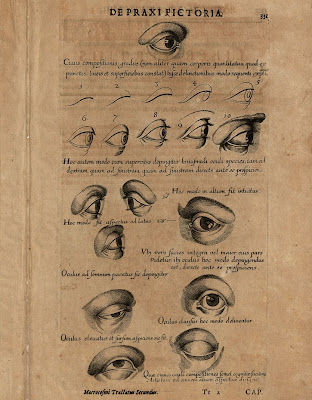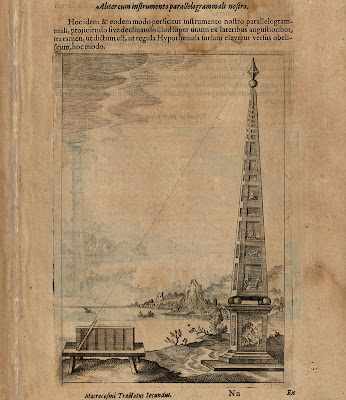






















These are further example illustrations from mystic rosicrucian Robert Fludd's 'De Naturae Simia'. This book forms part of the encyclopaedic series issued over 9 years to 1626 called 'Utriusque Cosmi Maioris Scilicet et Minores Metaphysica, Physica Atque Technica Historia'. Although it doesn't appear to be stated anywhere, I had a distinct feeling that the University of Utah website contains more than just the 'De Naturae Simia' illustrations.
The images above and in the previous post on Flood constitute a very small sampling of the veritable multitude of illustrations from Merian/de Bry seen throughout Fludd's work. Again, you can find the page/section locations for each image by checking the alt tags.
As with so many publications from this period it's difficult to speculate about the extent to which the contents may have been copied or modified from other sources. Certainly the machines and the fortification and perspective images above bear similarities to earlier works (think Dürer and Ramelli) but these subjects were at the forefront of technological theorizing during the renaissance so a certain repetition of core design principles (the waterwheel for instance) could be expected. There is also the influence and experience (and reused engraving plates!) that the printshop and illustrators brought to the projects.
Fludd is credited with one theoretical concept (not shown above) that, to an extent supports the notion that he contributed his own ideas, rather than merely extracting material from older sources. He described a perpetual motion system in which a water source would turn a wheel which in turn would be able to both grind grain and also drive an Archimedes screw pump to return the water to its origin, able to fall again and continue to power the process. It's completely fanciful of course but this was an era when there was no knowledge of the laws of thermodynamics and speculative entrepreneurs even attempted to obtain patents on aspects of Fludd's design up to the 19th century.
- Perpetual Motion.
- Professor Hibbert's Perpetual Motion Pages.
- Perpetual Futility - A short history of the search for perpetual motion.
- Will someone build a perpetual motion machine?
- The Museum of unworkable devices.
- HP-Gramatke: Perpetuum Mobile
- The complete scanned 'Utrisque cosmici' by Robert Fludd at the Max Planck Society ECHO Project.
No comments:
Post a Comment